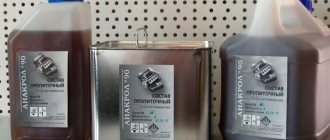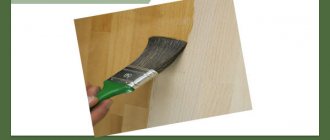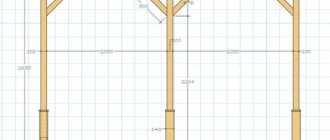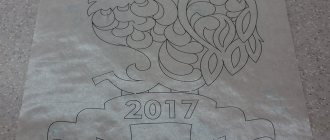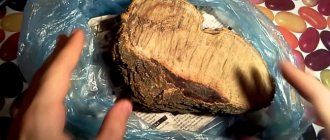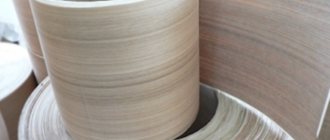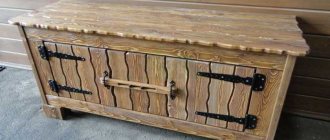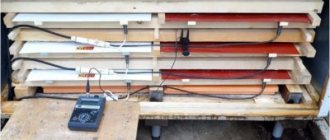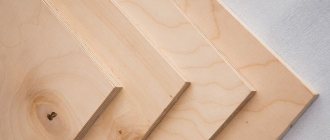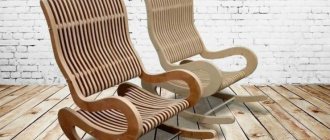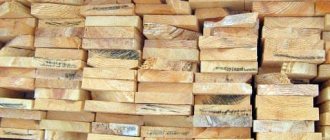Below we will write exactly how you can get bent plywood with your own hands and in production.
[contents]
More information about the material
Before bending plywood with your own hands, you need to familiarize yourself with such products in more detail. The product is a wood board obtained by gluing fragments of prepared veneer. To improve the strength properties, the fibers are positioned so that they are perpendicular to each other.
As for the number of layers, it may vary. Most often, sheets consist of an odd number of veneer layers. It is easiest to work with thin slabs, but their scope of application is limited to decorative functions. To construct arches or form volumetric structures of a round type, in any case, thick sheets will be required, which are quite problematic to bend.
The process of soaking elements
Craftsmen who are thinking about how to bend plywood at home without unnecessary difficulties can offer this option. It involves holding the sheets over a tank of boiling water or placing them directly into a liquid medium. Soaking time will depend on the type of product as well as its thickness.
The method of keeping slabs in water is more accessible and safe, so it is proposed to consider it in detail. However, when carrying out work, high-quality plywood must be used. Bad sheets can quickly delaminate. Before starting soaking, it is advisable to lower a small piece of material into a container of water. If nothing happened to it, then you can dip whole fragments.
Step by step actions will look like this:
- A workpiece of the required size is placed in water for a certain time. You can understand that the product is ready for further transformations by carrying out regular monitoring. The slab will become pliable.
- Soaking stops when the desired flexibility is achieved. The sheet itself is moved to a convenient place for work.
- The workpiece is bent and fixed with screws in a certain position until it dries completely.
At home, it is recommended to combine humidification with steaming. With this option, only the outer layer is saturated with water. The bend area is treated with steam. It is best to bend the sheets along the wood fibers, then you will be able to achieve the maximum effect.
Required tools and equipment
As always, it’s impossible to do without high-quality equipment and tools. Since the basic technology involves softening the sheet, molding it, and then drying it in an immobilized position to take its shape, bending requires at least a set of clamps. Ideally, there should be at least a dozen of them, but you can bend the plywood in stages, rearranging the fasteners.
In this case, along each line across the bend, the workpiece is fixed in three places: at the highest point of the radius and at the edges. In other words, with due diligence you can get by with six clamps, but keep in mind that the accuracy of the dimensions of the finished part may be significantly lower than required.
Plywood bending is almost always done using templates. The exception is sheets of arbitrary radius, which are pre-bent before sheathing frame structures. For risers of stairs, chairs, armchairs and other pieces of furniture, the shape of the bent parts is known with high accuracy. Therefore, you first need to make a spatial figure to which the softened sheet will be attached while it dries and takes on the required shape.
There are quite a few types of equipment that provide technologically advanced steaming or soaking of glue. Humidity and temperature must be kept within acceptable limits, otherwise the glue may irreversibly lose its strength properties. At home and for one-time work, you can use calorific heaters or films for heated floors. Wetting is best done not directly, but through a hygroscopic material that can accumulate and gradually release moisture, for example through foam rubber, hemp burlap or felt. It also helps to have all the adjustable tensioning and compression devices available, such as lashing straps or hand jacks.
Making frequent cuts along the bend
If the question is how to bend thick plywood, then an effective way is to create numerous notches in the right place. To create the cuts you will need a cutter. With its help, special stripes are made in a certain area of the wood board.
When working, do not make deep cuts. They should reach a maximum of half the thickness of the sheet. The veneer layer located on the opposite side must not be damaged. Modern boats are often made from slabs rounded using this technology.
So, how to bend plywood by making cuts in it, step by step:
- Frequent incisions are made in a specific location.
- The workpiece is given the desired shape by fixing it in the required position.
- Thick veneer is glued using PVA or epoxy resin.
- After about 24 hours, the fasteners are removed.
The cuts are best placed on the inside. When gluing veneer over them, voids are formed. If the manufactured structure is used carelessly, cracks may appear.
Bending according to templates
In the simplest case, the role of a template can be played by pieces of hard plywood shaped like a bending profile. Since most parts are bent along the same contour on both sides, the templates are made in pairs and then fastened together with spacers slightly smaller than the width of the part. Templates can also be different if it is necessary to bend a part of an irregular shape, that is, curved along two axes.
Another type of template is a frame made of beams that does not form an exact bending contour. In this case, the transverse bars are placed at the pressure points, that is, on the most protruding and concave parts of the part profile. For fastening at intermediate points, you can add an arbitrary number of jumpers to the frame.
When making the frame, you need to take into account the type of clamping devices used. Thus, plywood inserts can have holes for clamp jaws, and the frame itself can be equipped with additional stiffening ribs in the direction of pressure and tensile loads. If the part has a uniform bend along its entire length, it can be fixed without a frame, for example, tied with a rope, cable, chain with a screw tow bar, or using sling belts.
Method for gluing thin sheets
Before bending a thick sheet of plywood, you should consider using multiple boards. You can glue a number of fragments together, since bending them separately is much easier. However, when using low-quality glue, problems with delamination of the product may arise already at the initial stage of operation.
First, solid sheets are cut to obtain blanks of suitable sizes. All fragments are bent by hand and fixed to each other using epoxy glue. To avoid deformation changes, clamps must be used.
The final part is wiped off from the dried glue. Possible defects are removed from its surface. The last stage is sanding.
Recommendations from experts
In order to obtain a high-quality part as a result of the work, it is important to take into account the following points:
- folded sheets should be stored in a room with low air humidity (about 10%);
- the longitudinal bending radius is much larger than the transverse one;
- Steamed and soaked workpieces should be folded warm.
To obtain complex structures, it is better to contact a specialized company, which has powerful steam units and a variety of templates for giving plywood various shapes.
Some nuances
The above information makes it clear how to bend plywood in different ways. To achieve the best result, it is advisable to familiarize yourself with some subtleties:
- when soaking, it is allowed to bend the slabs only at elevated temperatures, otherwise cracks may appear;
- elements that will be given a curved shape should be stored in rooms with a stable level of humidity;
- If the purchased material is expensive, you can use the services of specialized companies.
Before bending plywood 10 mm or more, you need to decide on the method to be used. The option should be selected depending on the angle of the break. As for products of smaller thickness, they are bent only by soaking with water or steam.
How to bend plywood in a semicircle or into a pipe: choice of material
The maximum bending radius of plywood largely depends on the thickness of the sheet. Thin slabs of 3–4 mm deform quickly and quite easily. You are unlikely to have a problem bending plywood into a pipe - sheets up to 10 mm thick easily change shape under the influence of steam or hot water.
Furniture, arches, and stair railings are made of durable materials with a thickness of 15–22 mm, so the bending process is more labor-intensive and complex. In such cases, you need to gradually soak and bend the part, use the cutting method, or sequentially glue thin workpieces into an element of large thickness.
Humidification timing chart
To determine the number of minutes required to soak the material at a temperature of 95 degrees along the fibers, you can use the data presented.
| Number of layers | Thickness in millimeters | Time, min. |
| Three | 1 | 15 |
| 2 | 40 | |
| 3 | 90 | |
| 4 | 180 | |
| Five | 1 | 60 |
| 2 | 120 | |
| 3 | 180 | |
| 4 | 240 |
Advantages of using bent plywood
The above methods make it possible to give wood boards a smooth shape. In this case, arches, furniture and other decorative elements are aesthetically attractive and mechanically resistant. Curvilinear surfaces make it possible to:
- keep the number of angles to a minimum, thereby significantly reducing the risk of injury;
- give the interior sophistication, because the eyes are more interested in smooth transitions;
- reduce the number of fasteners.
Plywood sheets are indeed an excellent material for finishing work and furniture production. The ability to create curves opens up interesting design possibilities. When using bent shapes, stylish products and designs are obtained.
About choosing a method
Knowing how to bend plywood in three main ways, each master must decide on one of them. Each of the options is not universal; it is relevant in a particular situation.
Even the soaking process is not suitable for all cases. It cannot be used to make too strong bends, and it also takes a lot of time, especially if the thickness of the material is quite high.
The method of creating grooves for sheet compliance is not universal. It is not suitable for thin plywood. Typically, a bend is made if the thickness of the slab is at least 2 cm. As for the gluing technology, it can be considered the more universal of all of the above. However, it does not make sense to use it for thin sheets. It’s easier to bend them immediately using the soaking method.
